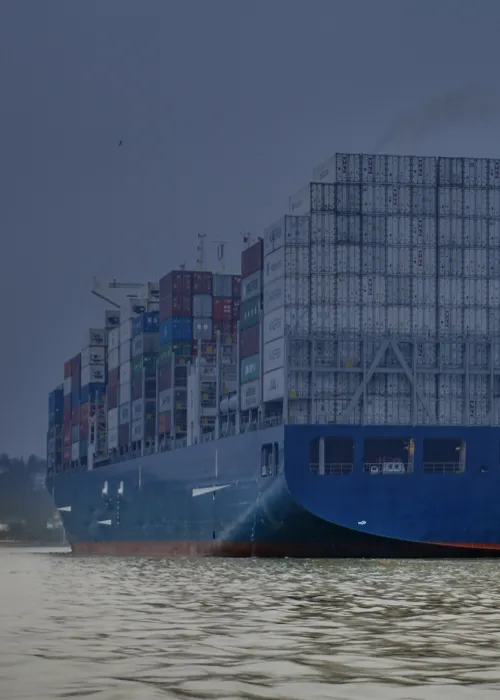
Products for the Maritime Sector
Our partners’ products are designed to enhance ships’ environmental footprint, for instance, by optimizing propulsion and reducing emissions of harmful substances such as carbon dioxide (CO2), nitrogen oxides (NOx), particulate matter (PM), and solid particle number (PN). Additionally, we offer solutions for ballast water treatment.

Products for the Maritime Sector
Our partners’ products are designed to enhance ships’ environmental footprint, for instance, by optimizing propulsion and reducing emissions of harmful substances such as carbon dioxide (CO2), nitrogen oxides (NOx), particulate matter (PM), and solid particle number (PN). Additionally, we offer solutions for ballast water treatment, which prevent the spread of invasive species and preserve marine biodiversity.

CO2 Reduction
CO2, as the primary greenhouse gas, is responsible for over half of global warming. Research indicates that approximately 3 to 4% of global CO2 emissions originate from maritime shipping.
Currently, there are global environmental regulations in place for maritime vessels, such as the Carbon Intensity Indicator (CII), but it is expected that inland shipping will also need to adhere to such regulations in the future.
NOx Reduction
The nitrogen issue is a global concern, impacting various sectors and regions worldwide. Also, the global maritime shipping industry is facing increasing pressure to comply with stricter environmental regulations aimed at reducing the emission of nitrogen oxides (NOx) from ships.
The IMO Tier III requirements have been in effect since January 1, 2016, in the designated NOx Emission Control Areas (NECA), while for inland shipping vessels, the Stage V emission requirements have been in effect since January 1, 2019.
PM Reduction
On the path towards emission-free and climate-neutral navigation, it is essential to reduce the emissions of particulate matter (PM) and solid particle number (PN) from your fleet, along with other emissions. Global environmental regulations are becoming increasingly stringent, and at the European level, enforcement of regulations concerning soot will also tighten. This change is already being observed through the implementation of Stage V emission standards.
Propulsion
In most cases, ships are still equipped with an open propeller or a ducted propeller and are traditionally powered by shafts driven by engines that increasingly use cleaner fuels nowadays.
However, in an era where environmental protection, cost-saving, and regulatory compliance are becoming increasingly important, improving the efficiency of your propulsion concept is considered a logical step.
For example, by investing in an energy-efficient stern with CFD-optimized appendages, ships can not only reduce their ecological footprint but also save costs on fuel and comply with stricter regulations.
Ballast Water Treatment
Ballast water is crucial for the stability of ships, but it can unintentionally spread harmful aquatic species, posing a threat to marine biodiversity. By effectively treating ballast water, ships can remove harmful organisms before the water is discharged. This not only prevents the spread of invasive species but also ensures that ships comply with increasingly strict international and national regulations.
CO2 Reduction
CO2, as the primary greenhouse gas, is responsible for over half of global warming. Research indicates that approximately 3 to 4% of global CO2 emissions originate from maritime shipping. Currently, there are global environmental regulations in place for maritime vessels, such as the Carbon Intensity Indicator (CII), but it is expected that inland shipping will also need to adhere to such regulations in the future.
NOx Reduction
The nitrogen issue is a global concern, impacting various sectors and regions worldwide. Also, the global maritime shipping industry is facing increasing pressure to comply with stricter environmental regulations aimed at reducing the emission of nitrogen oxides (NOx) from ships. The IMO Tier III requirements have been in effect since January 1, 2016, in the designated NOx Emission Control Areas (NECA), while for inland shipping vessels, the Stage V emission requirements have been in effect since January 1, 2019.
PM Reduction
On the path towards emission-free and climate-neutral navigation, it is essential to reduce the emissions of particulate matter (PM) and solid particle number (PN) from your fleet, along with other emissions. Global environmental regulations are becoming increasingly stringent, and at the European level, enforcement of regulations concerning soot will also tighten. This change is already being observed through the implementation of Stage V emission standards.
Propulsion
In most cases, ships are still equipped with an open propeller or a ducted propeller and are traditionally powered by shafts driven by engines that increasingly use cleaner fuels nowadays. However, in an era where environmental protection, cost-saving, and regulatory compliance are becoming increasingly important, improving the efficiency of your propulsion concept is considered a logical step. For example, by investing in an energy-efficient stern with CFD-optimized appendages, ships can not only reduce their ecological footprint but also save costs on fuel and comply with stricter regulations.
Ballast Water Treatment
Ballast water is crucial for the stability of ships, but it can unintentionally spread harmful aquatic species, posing a threat to marine biodiversity. By effectively treating ballast water, ships can remove harmful organisms before the water is discharged. This not only prevents the spread of invasive species but also ensures that ships comply with increasingly strict international and national regulations.
